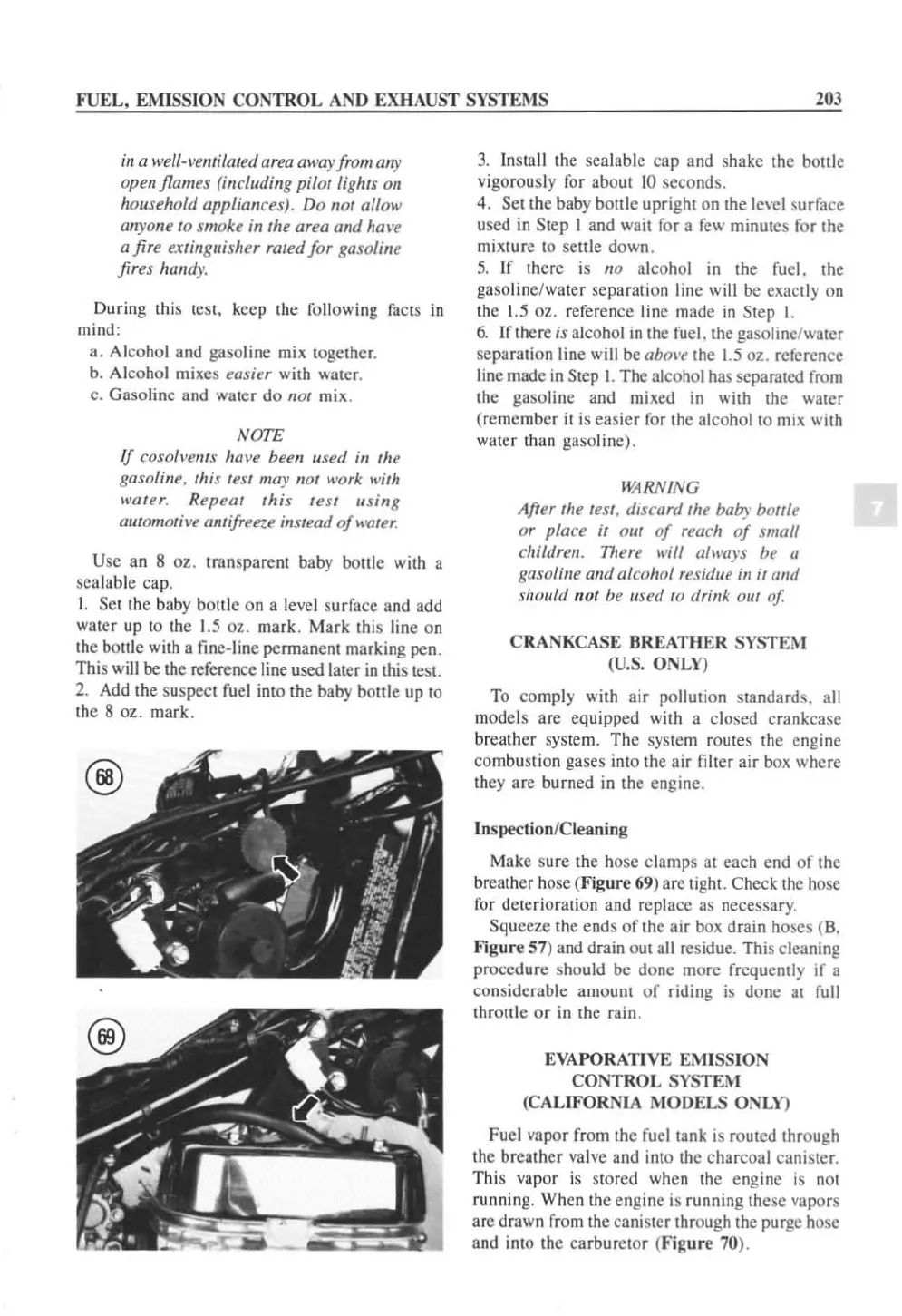FUEL, EMISSION CONTROL AND EXHAUST SYSTEMS
203
in
a lI'ell-I'elllilmetl area away from lilT)'
open
flames
(including
piiotlighlS
all
household
appliallces).
Do
1I0t
allow
anyone
to
smoke
in the area
and
hal
'e
a
fire
extinguisher rated
for
gasoline
fires
handy.
During this
le
st, keep the following
faclS
in
mind:
a.
Alcohol and gasoline
mix
together.
b. Alcohol mixes
easier wilh water.
c.
Gasoline and water do
nOt
mix
.
NOTE
If
cosoli'ellls have been
used
in the
gasoline, this test
may
not work with
water. R
epeat
this
test
using
aillomotil
'e
amifrene
instead
of
water.
Use an 8 oz. transparent baby bottle with a
sealable cap.
I. Set the baby bottle on a level surface and add
water
up
to
the
1.5
oz. mark. Mark
thi
s line on
the bottle with a fine-line pennanent marking pen.
This will
be
the reference line used later
in
thi
s test.
2. Add the suspect fuel into the baby bottle up
to
the 8 oz. mark.
@
3.
I
ns
ta
ll
the scalable cap and shake the bottle
vigorously
for
about 10 seco
nd
s.
4.
Set
the baby boule upright on the level surface
used
in
Step I and wait
for
a
few
minutes for the
mixture
to
seule down.
5.
If there is
no
alcohol
in
the
fu
el. the
gasoline/water separation line will
be
exac
tl
y on
the
1.5
oz. reference line made
in
Step I.
6.
If there is alcohol
in
the fuel, the gasoline/water
separation line will
be
abol
'e
the 1.5 oz. reference
lin
e
mad
e
in
Step I. The alcohol has separated
from
the gasoline and mixed
in
with the water
(rememb
er
it
is
easier
for
the alcohol
to
mix
with
water than gasoline).
WARNING
After
the
test, t/iscan/ till' baby bottle
or
place
it
Ollt
of
reach
of
smal/
chilt/ren. There will alll'a)"s
be
1I
gasoline
alU/
al
co
hol
residlle in it tIIlll
sholl/tf
not
be
IIset/
10
t/rink
Olll
of.
CRANKCASE BREATHER SYSTEM
(U.S.
ONLY)
To comply with air pollution standards, all
models are
eq
uipped with a closed crankcase
breather
sys
tem. The system routes
th
e engine
combustion gases into the air filter air box where
they arc burned in the engine.
I
nspt(
tion/Cleaning
Make
su
re the hose clamps at each end
of
the
breather
ho
se
(F
igure 69) arc tight. Check the hose
for
deterioration and replace
as
necessary.
Squeeze the ends
of
the air
box
drain hoses (
B,
Fig
ur
e 57)
and
drain oul all
re
sidue. This cleaning
procedure shou
ld
be done more frequently if a
considerable amount
of
riding
is
done
at
full
throttle
or
in the rain.
EVAPORATIVE EMISSION
CONTROL SYSTEM
(CALIFORNIA MODELS ONLy)
Fuel vapor from the
fuel
tank is routed through
the breather valve and into the charcoal canister.
This vapor
is
stored when the engine is
not
running. When the en
gi
ne
is
running these vapors
are drawn
from
the canister through the purge hose
and into the carburetor (Figure
70).

